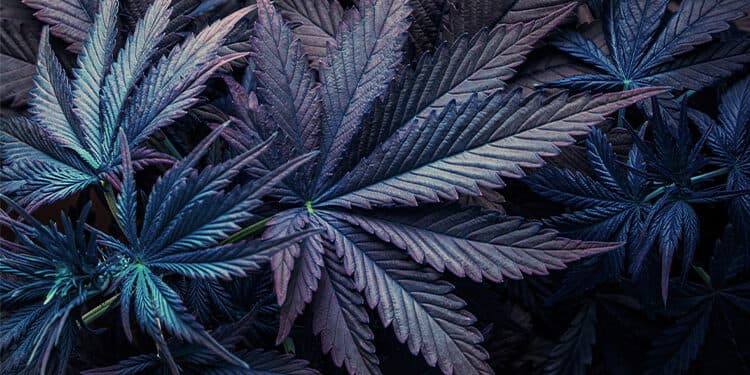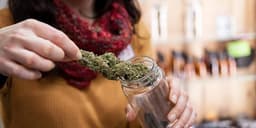Powered by Buddy
Menu
Powered by Buddy
Powered by Buddy
Menu
Powered by Buddy
How do you want to shop?
Blogs
Here’s Why Some Marijuana Strains Turn Purple
by All Green Dispensary | June 8, 2025

Have you ever seen purple marijuana strains and wondered what gets it that special color? Contrary to popular belief, purple marijuana isn’t any “stronger.” It’s a combination of environment and genetics. You may have noticed that there are specific strains that are known to be purple, such as Granddaddy Purple or Granddaddy Purps. That might lead someone to believe that those strains are always purple, but that’s not true. Genetically, some strains of marijuana can turn purple, blue, or pink. But that doesn’t mean that they actually will. This has to do with the amount of anthocyanin levels in the plant. Marijuana is more complicated than just THC, CBD, and numerous other cannabinoids; there’s a lot that goes into the breeding. High levels of anthocyanin will reflect purples, pinks, and blues, while low levels will reflect more yellows and golds. In the middle? Those lovely greens. Strains that don’t have the genetics for purpling are never going to go purple, regardless of their environment. So, if you want purple buds, you need to start with the right strain. But as mentioned, genetics simply means that the plant can go purple. It doesn’t mean that it will. Chlorophyll is what promotes the green color in all marijuana plants, and it’s an absence of that chlorophyll that lets purple, pink, and blue show through. As the plant matures, it creates less chlorophyll, but it still has to be “triggered” to produce more anthocyanin, even if it’s a strain that can produce more anthocyanin. The most common way to do this is a drop in temperature. During a temperature drop, the plant will react with more anthocyanin as a way to protect itself from the elements. While the production of anthocyanin is not deeply understood, it is known that taking a strain with the genetics for purple and dropping temperature during maturation is the easiest and most effective way of getting those beautiful, purple buds. Now, finally: Not only is purple marijuana not more potent (though it may be prettier), it actually could be less potent. This is because creating purple buds does mean that you have to put the marijuana plant under stress to provoke its color change. Stressed plants are more likely to produce less THC overall. So, you’re paying a cost for the attractiveness of the bud. That being said, that doesn’t mean that some strains may not be potent on their own. As marijuana scientists continue to create stronger and stronger strains, it’s very likely that a strong, high THC (or high CBD) strain could arise that also happens to have the genetics for purpling. Today, purple marijuana is mostly a novelty. The anthocyanin that creates purple marijuana doesn’t impact the actual effects of marijuana bud; it just creates a more attractive plant. But learning more about the genetics and the environment behind it underscores the complexities of marijuana farming, which is both an art and science for many professionals.The Genetics of a Purple Strain
Causing a Strain to Go “Purple”
Is Purple Marijuana More Potent?

Marijuana and Inflammation: A Natural Approach to Managing Chronic Conditions
In recent years, there has been a growing interest in the potential benefits of marijuana in addressing chronic inflammatory conditions. All Greens Dispensary, a pioneer in providing quality cannabis products, is committed to exploring and promoting the therapeutic aspects of marijuana. In this article, we delve into the relationship between marijuana and inflammation, shedding light on how it can be a natural ally in managing chronic inflammatory conditions. Chronic inflammatory conditions, such as arthritis, Crohn’s disease, and certain autoimmune disorders, can significantly impact the quality of life for those affected. Inflammation is the body’s natural response to injury or infection, but when it becomes chronic, it can lead to persistent discomfort, pain, and tissue damage. Conventional treatments often come with side effects, prompting many individuals to seek alternative, natural solutions. Marijuana contains a myriad of chemical compounds known as cannabinoids, with two primary players – THC (tetrahydrocannabinol) and CBD (cannabidiol). These cannabinoids interact with the endocannabinoid system in the body, a complex network of receptors that regulate various physiological processes, including inflammation. THC, the psychoactive compound in marijuana, has been studied for its anti-inflammatory properties. Research suggests that THC can modulate immune responses, potentially reducing inflammation. This makes it a promising option for individuals dealing with conditions where inflammation plays a key role. CBD, on the other hand, is a non-psychoactive cannabinoid that has gained attention for its anti-inflammatory and analgesic effects. It interacts with receptors in the endocannabinoid system, influencing immune responses and mitigating inflammation. CBD’s ability to provide relief without the psychoactive effects makes it an attractive option for those seeking natural alternatives. Arthritis, characterized by joint inflammation, can be particularly challenging. Studies have shown that marijuana’s anti-inflammatory properties may alleviate arthritis symptoms, providing relief to those experiencing joint pain and stiffness. Conditions like Crohn’s disease and ulcerative colitis fall under the umbrella of inflammatory bowel diseases. Research suggests that cannabinoids can modulate the gut’s inflammatory response, offering potential benefits for individuals dealing with these challenging conditions. Marijuana’s impact on the immune system is of interest in autoimmune disorders, where the body’s immune system mistakenly attacks its tissues. While more research is needed, some studies indicate that cannabinoids may help regulate immune responses, potentially offering therapeutic benefits for those with autoimmune conditions. At All Greens Dispensary, we understand the importance of providing a variety of options to cater to individual preferences and needs. Our range of marijuana products, including flower, edibles, tinctures, and topicals, allows customers to choose the method that aligns with their comfort and lifestyle. Consult with a Healthcare Professional: Before incorporating marijuana into your wellness routine, it’s crucial to consult with a healthcare professional, especially if you are currently on medication. Start Low and Go Slow: If you’re new to marijuana, start with a low dosage and gradually increase it as needed. This approach helps you gauge your body’s response and find the optimal dosage. Explore Different Products: All Greens Dispensary offers a diverse selection of products. Experiment with different forms, such as tinctures, edibles, or topicals, to discover what works best for you. Monitor Your Symptoms: Pay attention to how your body responds to marijuana. Keep track of changes in symptoms and discuss them with your healthcare provider for personalized guidance. Marijuana’s potential role in managing chronic inflammatory conditions opens new avenues for individuals seeking natural alternatives. All Greens Dispensary is dedicated to providing premium-quality marijuana products, backed by a commitment to customer wellness. As you explore the possibilities of incorporating marijuana into your wellness routine, remember to make informed decisions, consult with healthcare professionals, and leverage the diverse product offerings at All Greens Dispensary.Understanding Chronic Inflammation
The Role of Cannabinoids in Inflammation
THC’s Anti-Inflammatory Properties
CBD: A Non-Psychoactive Anti-Inflammatory Agent
How Marijuana May Help Specific Conditions
Arthritis
Inflammatory Bowel Diseases (IBD)
Autoimmune Disorders
Navigating the Options at All Greens Dispensary
Tips for Incorporating Marijuana into Your Wellness Routine
All Greens Dispensary For Natural Alternatives To Managing Your Chronic Inflammatory Conditions
All Greens Dispensary
June 5, 2025
Menu




